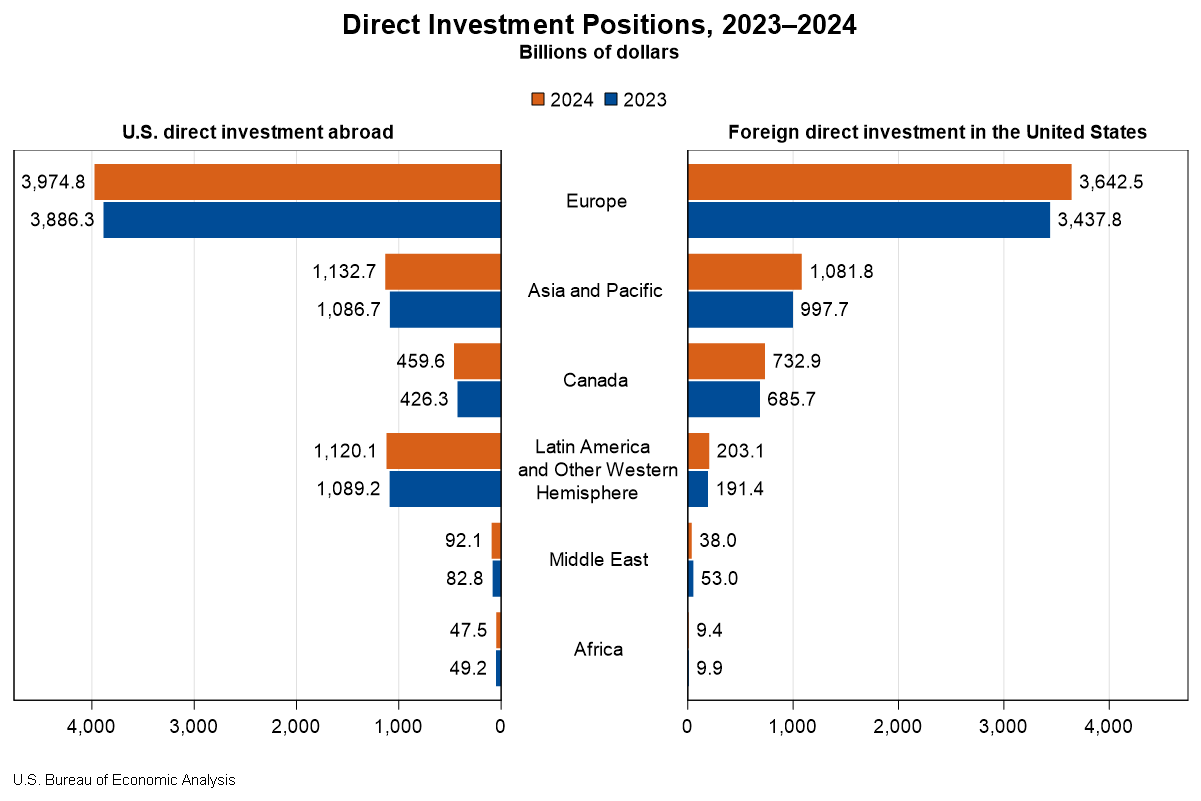Bureau of Economic Analysis
Direct Investment by Country and Industry, 2024
The U.S. direct investment abroad position, or cumulative level of investment, increased $206.3 billion to $6.83 trillion at the end of 2024, according to statistics released today by the U.S. Bureau of Economic Analysis. The increase was led by an $88.4 billion increase in the position in Europe, primarily in Luxembourg and Germany. By industry, manufacturing affiliates had the largest increase, led by manufacturing of computers and electronic products.
The foreign direct investment in the United States position increased $332.1 billion to $5.71 trillion at the end of 2024. The increase was led by a $204.7 billion increase in the position from Europe, which reflected a $52.9 billion increase from the United Kingdom and a $39.7 billion increase from Germany. By industry, affiliates in manufacturing increased the most.
Principal Federal Economic Indicators
Noteworthy
- 2025 News Release Schedule
- Innovation at BEA
- 2025 Annual Updates
- New! Services Trade Data for More Countries
- Data Tool: Trade in Value Added
- Distribution of State Personal Income
- Updated: RIMS II Regional Multipliers
- Arts and Culture
- Space Economy
- FDI Now in State BEARFACTS
- Quick Guide: Price Indexes
The Latest
U.S. International Trade in Goods and Services, September 2018
The U.S. monthly international trade deficit increased in September 2018 according to the U.S. Bureau of Economic Analysis and the U.S. Census Bureau. The deficit increased from $53.3 billion in August (revised) to $54.0 billion in September, as imports increased more than exports. The previously published August deficit was $53.2 billion. The goods deficit increased $0.6 billion in September to $77.2 billion. The services surplus decreased $0.1…
Gross Domestic Product by Industry: Second Quarter 2018
Information; real estate and rental and leasing; and professional, scientific, and technical services were the leading contributors to the increase in U.S. economic growth in the second quarter of 2018. Overall, 16 of 22 industry groups contributed to the 4.2 percent increase in real GDP in the second quarter.
Gross Domestic Product by Industry: Second Quarter 2018
Information; real estate and rental and leasing; and professional, scientific, and technical services were the leading contributors to the increase in U.S. economic growth in the second quarter of 2018. Overall, 16 of 22 industry groups contributed to the 4.2 percent increase in real GDP in the second quarter.
GDP Statistics for U.S. Counties Coming Dec. 12
For the first time, the Bureau of Economic Analysis is measuring the gross domestic product of the more than 3,000 counties in the United States. Prototype GDP statistics for each county will be published on our website Dec. 12.
Durable Goods Spending Rises in September
Personal income increased 0.2 percent in September after increasing 0.4 percent in August. Wages and salaries, the largest component of personal income, increased 0.2 percent in September after increasing 0.5 percent in August.
Personal Income and Outlays, September 2018
Personal income increased 0.2 percent in September after increasing 0.4 percent in August. Wages and salaries, the largest component of personal income, increased 0.2 percent in September after increasing 0.5 percent in August.
GDP Increases in Third Quarter
Real gross domestic product (GDP) increased 3.5 percent in the third quarter of 2018, according to the “advance” estimate released by the Bureau of Economic Analysis. In the second quarter of 2018, real GDP increased 4.2 percent.
GDP highlights
Gross Domestic Product, 3rd quarter 2018 (advance estimate)
Real gross domestic product (GDP) increased 3.5 percent in the third quarter of 2018, according to the “advance” estimate released by the Bureau of Economic Analysis. In the second quarter of 2018, real GDP increased 4.2 percent.
CNMI GDP Increases in 2017
The estimates of GDP for the CNMI show that real GDP—GDP adjusted to remove price changes—increased 25.1 percent in 2017 after increasing 28.2 percent in 2016. For comparison, real GDP for the United States (excluding the territories) increased 2.2 percent in 2017 after increasing 1.6 percent in 2016.
Northern Mariana Islands’ GDP Increases in 2017
The estimates of GDP for the Commonwealth of the Northern Mariana Islands show that real GDP—GDP adjusted to remove price changes—increased 25.1 percent in 2017, after increasing 28.2 percent in 2016. For comparison, real GDP for the United States (excluding the territories) increased 2.2 percent in 2017 after increasing 1.6 percent in 2016.




